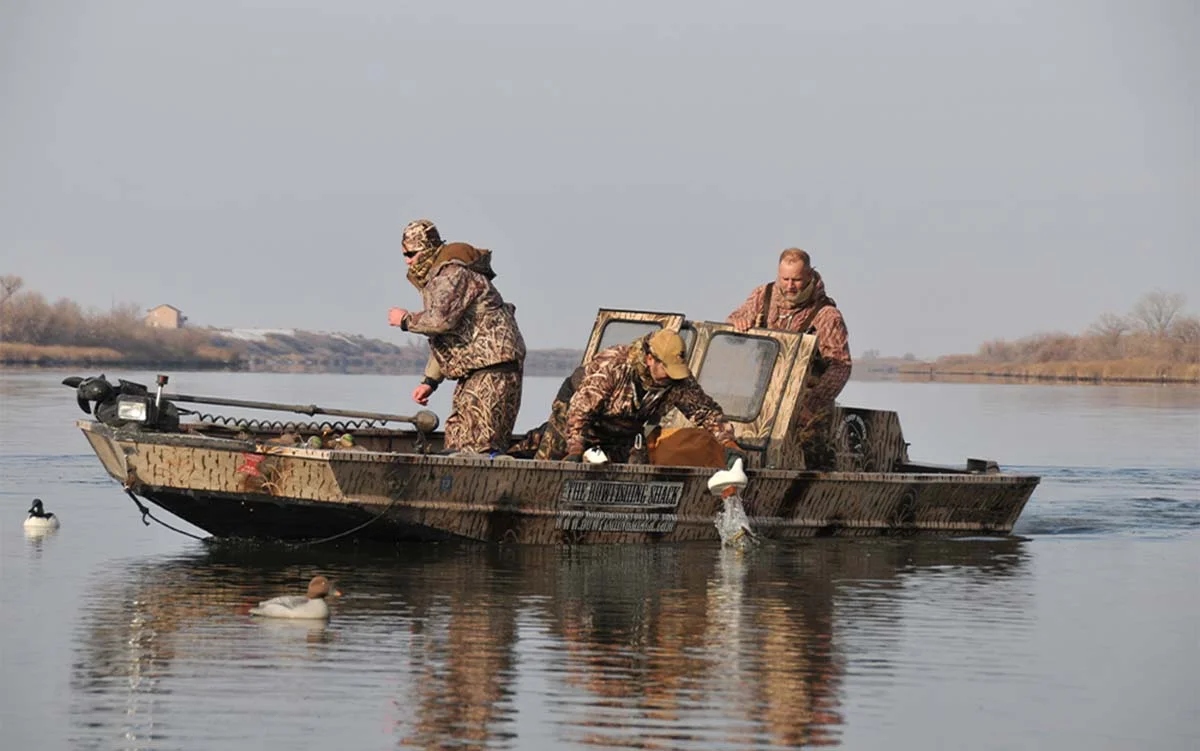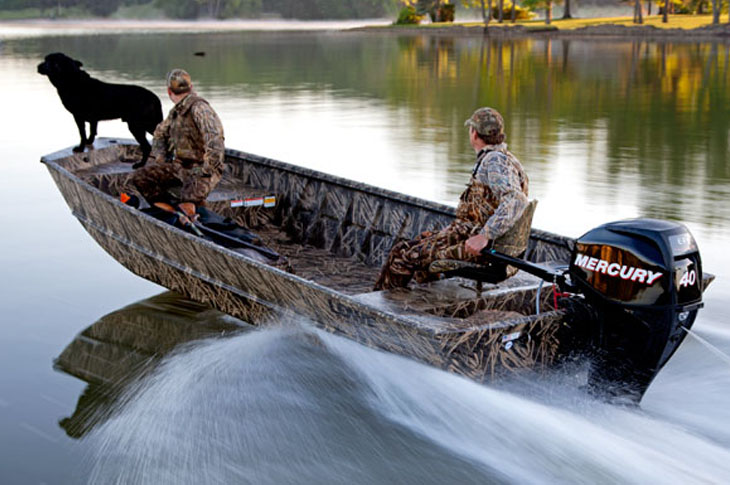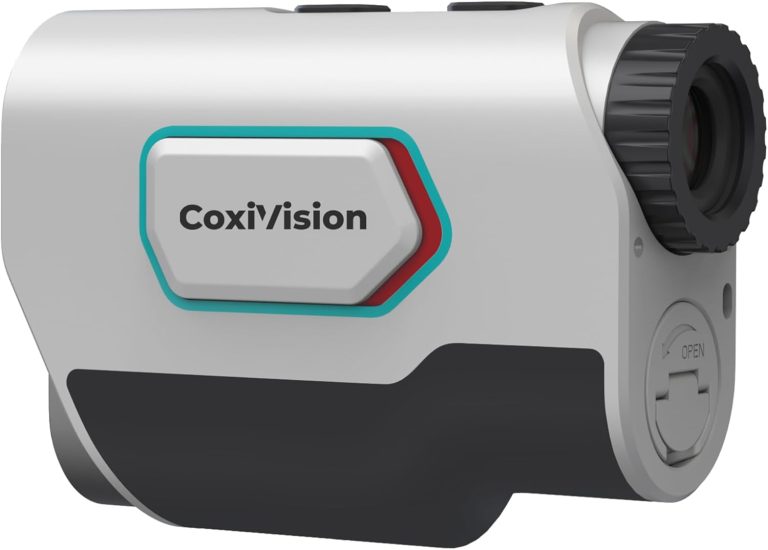When embarking on a waterfowl hunting adventure, the safety of all participants should be a primary concern. Among the various scenarios hunters may find themselves in, hunting from a boat presents unique challenges. In particular, two hunters in one boat must be exceptionally aware of their positioning, movements, and muzzle control to ensure an incident-free hunting experience. In this detailed exposition, we’ll break down the safest positions for two hunters duck hunting in a boat.
Points To Consider While Two Hunters Are Duck Hunting

Understanding the Basics of Gun Safety
Before delving into positioning, it’s imperative to reinforce the essential firearm safety rules:
- Always Treat the Gun as Loaded: Even if you believe it’s unloaded, always act as if it is.
- Muzzle Awareness: Always point the gun in a safe direction, away from yourself, your hunting partner, and the dog (if you have one).
- Keep Your Finger Off the Trigger: Until you’re ready to shoot, your finger should be away from the trigger.
- Be Certain of Your Target and Beyond: Ensure you’re shooting at a duck and be aware of what lies behind your target.
Choosing the Right Boat

The size and stability of the boat are paramount. A boat specifically designed for hunting, like a “jon boat” or a “duck boat,” is ideal. These boats tend to be flat-bottomed, providing better stability in the calm, shallow waters typical of duck hunting locales.
The Ideal Seating Arrangement
- Back-to-back: This is the most recommended seating arrangement. With one hunter facing the bow (front) and the other facing the stern (back), each hunter has a clear field of fire without crossing the other’s line of sight. It also prevents swinging too far left or right and pointing the muzzle at the other person.
- Advantage: This positioning minimises the chances of either the hunter accidentally swinging their firearm into the line of sight or the space of the other.
Shooting Zones
Establish clear shooting zones for each hunter.
- Hunter Facing the Bow: Their zone can be from the immediate left to the front and up to the middle of the boat.
- Hunter Facing the Stern: Their zone starts from the immediate right to the back, and again, up to the middle of the boat.
Both hunters should communicate and avoid shooting at ducks that fly directly overhead or behind the boat, as this can lead them to swing their guns out of their zones and risk pointing them at their partner.
Navigating Potential Obstacles
In areas where the water is filled with decoys, tree stumps, or aquatic plants, careful navigation is key. A sudden jolt or unexpected movement can throw off the hunter’s balance, especially during the act of shooting.
Handling the Dog: If there’s a retriever on board, ensure it’s trained to stay calm and in one place until sent to retrieve. A coon dog that moves unpredictably can cause instability or, worse, accidentally knock guns over.
Clear Communication:
Both hunters should always communicate their intentions clearly. If one needs to stand or move, the other should be informed to ensure they don’t shoot at that time. Simple commands like “taking the shot,” “bird on the right,” or “standing up” can be crucial.
When Not Shooting: When not actively hunting or during lulls in duck movement, both hunters should have their guns on safety and preferably laid down with the muzzle pointing towards the bow or stern, away from the occupants.
Boarding and Exiting the Boat:
- Stable Grounding: Before either the hunter boards or exits the boat, ensure it is grounded securely. It’s preferable to do this in shallow water where both hunters can maintain their footing.
- Unload First: Always unload firearms before entering or exiting the boat. This minimises the risk of accidental discharges.
Weight Distribution:
- Balanced Load: It’s crucial to distribute weight in the boat evenly. This includes both hunters, gear, and any game collected. An unbalanced boat can capsize or make shooting unstable and unsafe.
- Centralised Gear: Place heavy gear, such as decoy bags or coolers, in the boat’s centre to maintain stability.
Weather and Environmental Considerations:
- Awareness of Tides & Currents: In tidal waters, be aware of the tide’s direction and speed. An incoming or outgoing tide can shift the boat’s position, potentially moving it into unsafe territories or altering the defined shooting zones.
- Be Wary of Winds: High winds can drift the boat and affect the shot’s trajectory. It’s essential to account for the wind when taking a shot and ensure the boat is anchored securely in windy conditions.
Personal Flotation Devices:
Always wear them: Both hunters should always have a PFD on. Even in shallow waters, accidents can happen, and a PFD can be a lifesaver, especially if one is weighed down by gear or injured.
Onyx MoveVent Dynamic Paddle Sports CGA Life Vest


| Brand | Onyx |
| Color | Aqua |
| Age Range (Description) | Adult |
| Life Vest Type | Type III |
| Material | Nylon |
About this item
- Mesh in lower back fits high back seats
- Shoulder adjustments with neoprene comfort pads
- SOLAS grade reflective material for visibility
- Expandable zippered pockets with mesh drainage
- Heavy duty nylon fabric; soft, lightweight flotation foam
- Double crimp, funnel entry
- Expandable zippered pocket with mesh drainage
- 200 denier nylon ripstop and nylon oxford
- Attached is a whistle for safety
- Zip-assisted loop at zipper base U.S. Coast Guard-approved Type III Life Jacket / Personal Flotation Device (PFD)
Emergency Protocols:
- Established Plans: Both hunters should discuss and have a clear understanding of what to do in case of emergencies. This can range from a firearm malfunction, injury, sudden weather change, or even an unexpected encounter with wildlife.
- Carry a First-Aid Kit: Ensure the boat is equipped with a first-aid kit suitable for treating minor injuries and that both hunters know its contents and usage.
EVERLIT 250 Pieces Survival First Aid Kit IFAK EMT Molle Pouch Survival Kit Outdoor Gear Emergency Kits Trauma Bag for Camping Boat Hunting
| Brand | EVERLIT |
| Special Feature | Camping |
| Number of Pieces | 250 |
| Recommended Uses For Product | Emergency |
| Color | Od Green |
About this item
- ✅【250 PCS First Aid Survival Kit, Meaningful and Cool Gifts Ideas for Families and Outdoorsman】Designed by army veterans and survivalists, the most compact and robust survival first aid kit contains essential first aid supplies and survival tools required for emergencies. Weighing only 2 lbs., the kit is a must-have for your bug-out bag.
- ✅【Be Prepared for the Unexpected, Complete Comprehensive First Aid Essentials Exceeds OSHA Guidelines】The product includes more than enough medical supplies to treat a single family under emergency circumstances. Perfect for taking care of any medical or emergency needs during outdoor wilderness adventures such as camping, backpacking, boy scouts, hiking, hunting, and mountain biking.
- ✅【Molle EMT Pouch, Durable, Portable, and Water-Resistant】The military grade bag was made from 1000D water-resistant nylon. It offers three large compartments and many straps to get your supplies organised. The overall dimension of the kit is 8’’ x 6.5’’ x 5’’. The kit can be attached to any molle system: backpack, vest, or vehicle molle panel.
- ✅【Top Quality Survival Gears to Safeguard Your Next Adventure】Stuffed with the most essential survival gadgets: mylar space blanket, 3-mode tactical flashlight, multi-function paracord bracelet (compass, whistle), flintstone, knife, sabre card, two 12 hour glow sticks, and an emergency rainponcho.
- ✅【All Weather, All Age, Multi-Purpose Survival Kit】From outdoor actions to general home and office needs, for the outdoorsman, preppers to boy scouts. With its comprehensive contents and coverage, you will be prepared anywhere you go.
Maintenance Checks:
- Boat Inspection: Regularly inspect the boat for any damages or issues that might compromise safety. This includes checking for leaks, ensuring oars or motors are in good working condition, and checking the integrity of anchors or tie lines.
- Gun Maintenance: A well-maintained gun is more efficient and safer. Regularly clean and inspect firearms to ensure they’re in optimal working condition.
Alcohol and drugs:
Absolute Prohibition: Alcohol and drugs, including certain prescription medications, can impair judgement, coordination, and reaction times. They have no place in hunting scenarios, especially in a boat, where the margin for error is minimal.
Appropriate Hunting Gear:
- Non-Slip Footwear: Given the wet environment of a boat, wearing footwear with a good grip can prevent slips or falls, especially when standing to take a shot or navigating around the boat.
- Bright Colours: Although camouflaging is often recommended for hunting, having at least one item of brightly coloured clothing (like an orange cap) can be crucial for visibility, especially in low-light conditions or foggy environments.
Communication Tools:
- Whistles: Carrying a whistle can be a lifesaver, especially if you get separated or in case of emergencies. It’s louder than shouting and can signal distress effectively.
- Radios: If hunting in a larger area, having a set of radios can help maintain communication, especially if the hunters decide to momentarily split up or if they’re scouting different areas.
Knowing Your Surroundings
- Scouting: Before the hunt, scout the area. Know where the land is, the depth of the waters, potential hazards, and the best places to anchor your boat.
- Local Regulations: Familiarise yourself with local hunting regulations, including shooting hours, bag limits, and any restricted areas.
Load and Unload Zone:
Designated Areas: Establish a clear zone in the boat where guns are to be loaded and unloaded. This minimises movement with loaded firearms and confines potential accidental discharges to a predictable direction.
Swinging and Overhead Shots:
Establish Boundaries: While it’s tempting to take overhead or near-overhead shots, these can be dangerous in a boat. Set clear rules about which angles are acceptable to avoid accidentally pointing a firearm in the direction of the other hunter.
Avoid Overcrowding:
Limit Equipment: Bring only the necessary equipment. An overcrowded boat can restrict movement and create tripping hazards. Plus, in the case of the boat capsizing, fewer loose items can be beneficial.
Regular Drills:
Safety Drills: Just like fire drills, conducting regular safety drills can help in cases of emergencies. Practice scenarios like what to do if someone falls overboard, how to react to a capsizing boat, or how to handle a misfire.
Night Hunting Precautions:
- Visibility Tools: If hunting during dawn or dusk, ensure that the boat is equipped with appropriate lighting as mandated by local regulations. Reflective materials or markers can also help improve visibility.
- Noise Levels: At night, sounds travel further. Be more conscious of noise levels to avoid spooking ducks or alerting other nearby hunters to your position.
BUYSIGHT Rechargeable Spotlight

Use of Decoys:
Decoy Placement: When setting up or collecting decoys, ensure the boat is anchored securely, and firearms are unloaded. It’s also a good practice for only one hunter to manage the decoys while the other ensures stability and safety.
Regular Breaks:
Combat Fatigue: Hunting can be tiring, especially when maintaining heightened awareness for extended periods. Take regular breaks, hydrate, and stretch. Fatigue can lead to mistakes, so ensure both hunters are alert and refreshed.
Conclusion:
When two hunters take to the waters for a duck hunting session, preparedness and meticulous attention to safety can make all the difference. By incorporating these extensive safety measures and best practices, hunters can focus on the thrill of the hunt, confident in their shared commitment to safety.















